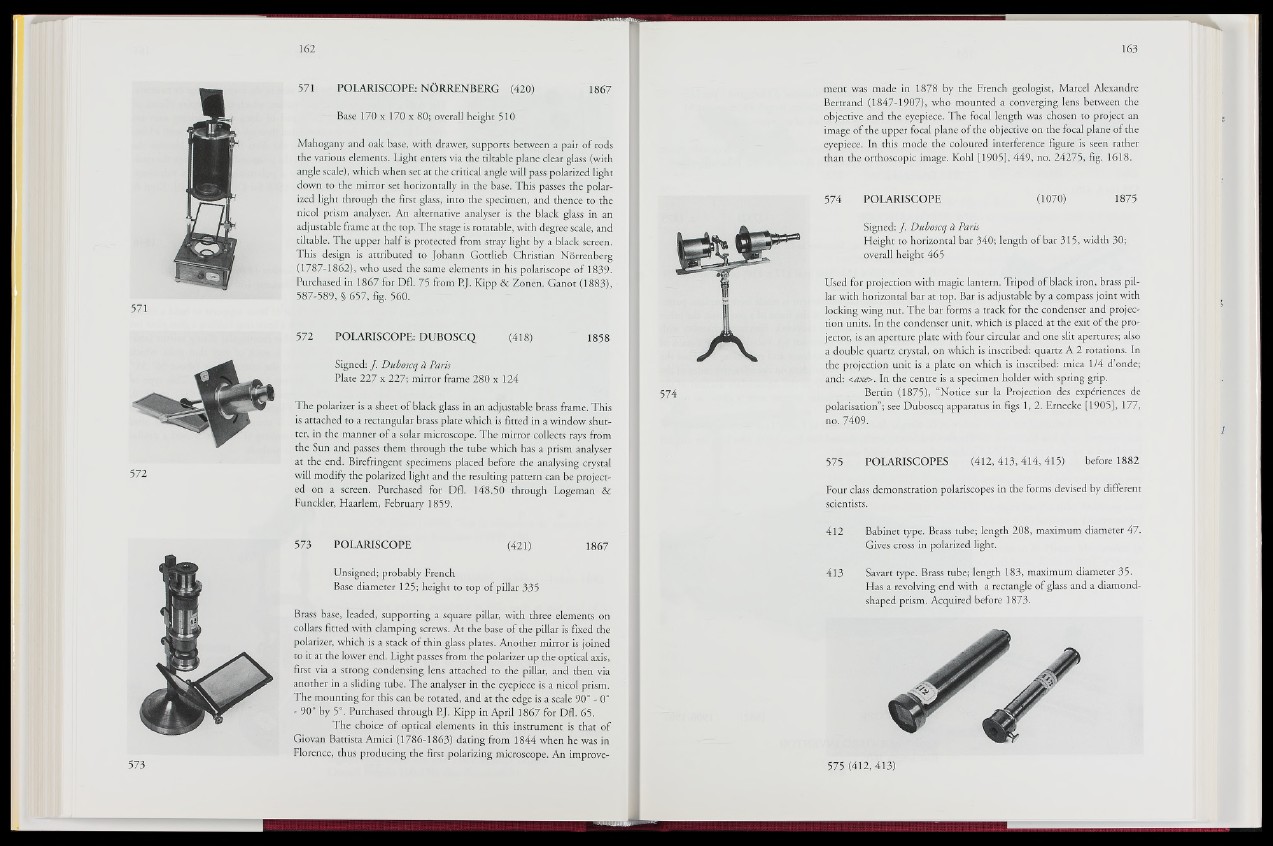
571 POLARISCOPE: NÛRRENBERG (420) 1867
Base 170 x 170 x 80; overall height 510
Mahogany and oak base, with drawer, supports between a pair of rods
the various elements. Light enters via the til table plane clear glass (with
angle scale), which when set at the critical angle will pass polarized light
down to the mirror set horizontally in the base. This passes the polarized
light through the first glass, into the specimen, and thence to the
nicol prism analyser. An alternative analyser is the black glass in an
adjustable frame at the top. The stage is rotatable, with degree scale, and
tiltable. The upper half is protected from stray light by a black screen.
■Shis design is attributed to Johann Gotdieb Christian Nôrrenberg
(1787-1862), who used the same elements in his polariscope of 1839.
Purchased in 1867 for Dfl. 75 from PJ. Kipp & Zonen. Ganot (1883),
587-589, § 657, fig. 560.
572 POLARISCOPE: DUBOSCQ (418) 1858
Signed: J. Duboscq à Paris
Plate 227 x 227; mirror frame 280 x 124
The polarizer is a sheet of black glass in an adjustable brass frame. This
is attached to a rectangular brass plate which is fitted in a window shutter,
in the manner of a solar microscope. The mirror collects rays from
the Sun and passes them through the tube which has a prism analyser
at the end. Biréfringent specimens placed before the analysing crystal
will modify the polarized light and the resulting pattern can be projected
on a screen. Purchased for Dfl. 148.50 through Logeman &
Funckler, Haarlem, February 1859.
573 POLARISCOPE (421) 186/1
Unsigned; probably French
Base diameter 125; height to top of pillar 335
Brass base, leaded, supporting a square pillar, with three elements on
collars fitted with clamping screws. At the base of the pillar is fixed the
polarizer, which is a stack of thin glass plates. Another mirror is joined
to it at the lower end. Light passes from the polarizer up the optical axis,
first via a strong condensing lens attached to the pillar, and then via
another in a sliding tube, The analyser in the eyepiece is a nicol prism.
The mounting for this can be rotated, and at the edge is a scale 9 0 l 0 W
- 90” by 5“. Purchased through P.J. Kipp in April 1867 for Dfl. 65.
’- ’The choice of optical elementsflh this instrument is that of
Giovan Battista Amici (1786-1863) dating from 1844 when he was in
Florence, thus producing the first polarizing microscope. An improvement
was made in 1878 by the French geologist, Marcel Alexandre
Bertrand (1847-1907), who mounted a converging lens between the
objective and the eyepiece. The focal length was chosen to project an >
image of the upper focal plane of the objective on the focal plane of the
eyepiece. In this mode the coloured interference figure is seen rather
than the orthoscopic image. Kohl [1905], 449, no. 24275, fig. 1618.
574 POLARISCOPE (1070) 1875
Signed: /. Duboscq à Paris
Height to horizontal bar 340; length of bar 315, width 30;
overall height.465
Used for projection with magic lantern. Tripod of black iron, brass pillar
with horizontal bar at top. Bar is adjustable by a'compass joint with
locking wing nut. The bar forms a track for the condenser and projection
units. In the condenser unit, which is placed at the exit of the projector,
is an aperture plate with four circular and one slit apertures; also
a double quartz crystal, on whiçli is inscribed: quartz A 2 rotations. In
the projection unit is a plate on which is inscribed: mica 1/4 d’onde;
and: <axe>. In the centre is a specimen holder with spring grip.
Bertin (1875), “Notice sur la Projection des expériences de
polarisation”; see Duboscq apparatus in figs 1, 2. Ernecke [1905],,
nm.7409.
575 POLARISCOPES | l | 2 , 413, 414, 415) before 1882
Four class demonstration polariscopes in the forms devised by different
scientists.
P i 2 Babinet type. Brass tube; length 208, maximum diameter 47.
Gives cross in polarized light.
413 Savart type. Brass tube; length 183, maximum diameter 35.
Has a revolving end with a rectangle of glass and a diamondshaped
prism. Acquired before 1873.